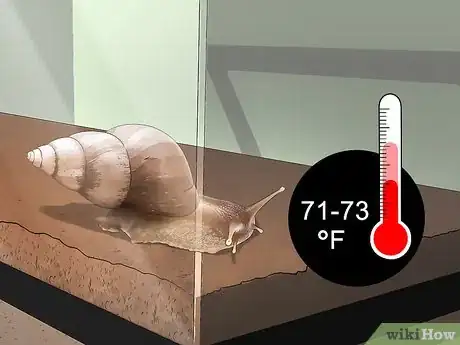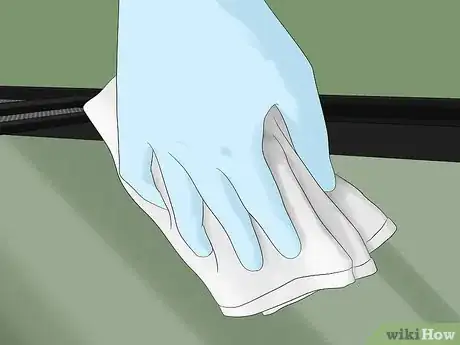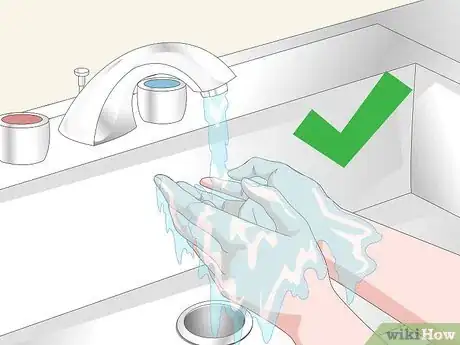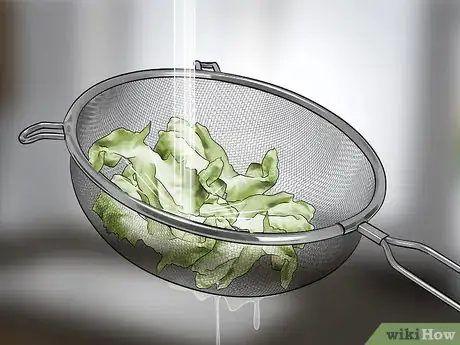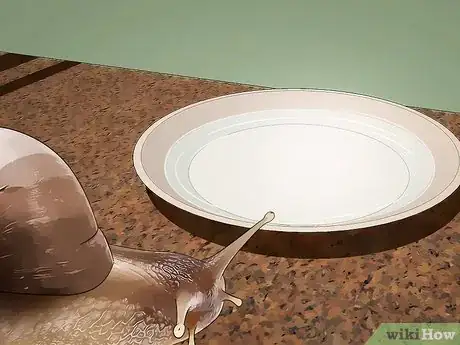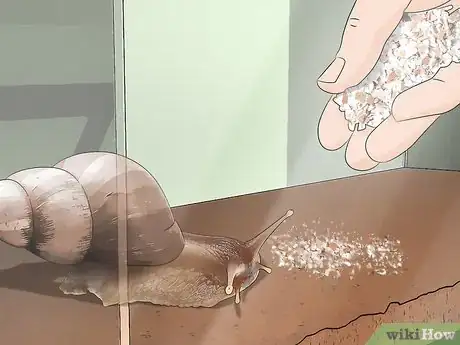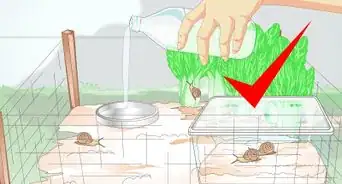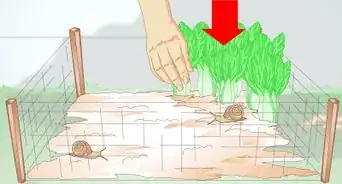This article was co-authored by Pippa Elliott, MRCVS. Dr. Elliott, BVMS, MRCVS is a veterinarian with over 30 years of experience in veterinary surgery and companion animal practice. She graduated from the University of Glasgow in 1987 with a degree in veterinary medicine and surgery. She has worked at the same animal clinic in her hometown for over 20 years.
wikiHow marks an article as reader-approved once it receives enough positive feedback. This article received 25 testimonials and 90% of readers who voted found it helpful, earning it our reader-approved status.
This article has been viewed 460,821 times.
Giant African Land Snails are native to East Africa, but they have adapted to many other countries, as they are an invasive species. They can grow to 10 inches or 25 centimeters in length. In countries where they can be legally kept, they can make good pets, as they are relatively low maintenance and fascinating to watch. If you decide to get a giant African land snail, you'll need to house it, provide hygiene care, and give it regular fresh produce.
Steps
Housing the Giant African Land Snail
-
1Find an aquarium with a tightly fitting lid. While the snail needs ventilation, it's also important that the lid of its container fits tightly, as it will climb out if given a chance. An aquarium works well or really any plastic or glass container that has a tight lid.
- Skip wooden containers, as the splinters harm the snail.
- For two snails, your container will need to be at least 25.5 inches (65 centimeters) by 18 inches (45 centimeters) by 16 inches (40 centimeters).
- It's fine to keep a snail alone or with a partner. However, snails are hermaphrodites, so if you have more than one in the same container, you're likely to end up with baby snails.
-
2Add a substrate. The substrate is basically the flooring your snail needs to be content. Snails like dirt, but you need to use peat-free compost.[1] Don't use what you have in your yard, as it can contain chemicals that will hurt your snail.
- Use 1 to 2 inches of the material (about 3 to 6 centimeters).
- Since snails like to burrow, you should provide a deeper area in the tank where they can dig. It's a good idea to put a hideaway spot nearby for the snail's enjoyment.
Advertisement -
3Moisten the substrate. The compost you use needs to be kept moist for the snail to be happy. It doesn't need to be soaking wet. Rather, it just needs to be kept damp. Use a spray bottle to spray it down and keep it damp.[2]
- Spray the tank lightly each day to dampen the soil and maintain proper humidity.
-
4Keep your snail warm. The temperatures at which each species is happiest can vary. The Lissachatina Fulica, for example, needs a tank ideally between 22-24 degrees celcius, while the Achatina Achatina or Tiger snail prefers it warmer at 27-29 degrees celcius. The best way to achieve a warmer temperature (if the room isn't warm enough) is to place a heating pad on the side of the snail's tank. You shouldn't place it under the tank as this will dry out the substrate. Only place it on half the tank so the snail has somewhere to go to cool down if need be. It also is vital that you use a thermostat with any heat pad to control the temperature range of the tank. Heat pads can have temperature malfunctions and potentially kill your snail and are not good at controlling temperature alone.
- Keep track of the minimum temperature in the tank with a thermometer in the colder side of the tank to ensure it's in the ideal range of the species you keep.
-
5Provide indirect sunlight. Snails need some light to be happy. However, indirect sunlight is best. Full sunlight is too harsh for the snails, and they'll stay hidden whenever possible.
-
6Watch for signs of unhappiness. If your snail doesn't like the conditions of its house, it will likely close itself up in its shell, creating a papery white seal at the opening. This has two main causes; a lack of humidity- called aestivation, or a lack of warmth- called hibernation. If your snail is in aestivation or hibernation, revise your care and see if there might be something that needs ammending- and fix them. Snails will (with a few rare exceptions) destroy their seal and come out within a few days of the issue being resolved. Unless there is a serious concern for the snail's safety, NEVER force a snail out of either of these conditions, as methods like putting them in water can drown them, and removing the seal by hand can very easily hurt the snail if it has stuck itself to the seal.[3]
Practicing Proper Hygiene
-
1Wipe down the tank when it looks dirty. When you notice the tank starts to look smeared or dirty, it's time to wipe it down. Just use a damp cloth to wipe down the sides and the lid.
-
2Aerate the substrate weekly. You can also check for eggs during this time. NEVER change the substrate at all as they need the bacteria in old substrate to stay healthy
- You don't want to use cleaners or disinfectants, as the snails will absorb those through their skin.
-
3Wash your hands thoroughly. After you do anything with your snail you need to wash your hands well. Using warm water and soap, scrub them for at least 20 seconds before rinsing.[4]
- Though the risk is low, snails can act as an intermediate host for certain parasites.[5] Washing your hands well is important for protecting yourself from possible parasites.
Feeding the Snail
-
1Feed a well-balanced, nutritional diet. Foods like cucumber and lettuce should be avoided as they are not nutritious, but snails will enjoy a diet of vegetables and a source of protein one/two times a week.
- Fruit should be fed as little as possible as it can cause health problems.
- The best sources of protein are "scud" shrimp and mealworms, but unseasoned raw meat can also be used.[6]
- Some favourites are corn and bell peppers, as well as zucchini, grapes, melons, watercress, and spinach.
- Always check up on the food, and remove it when it's gone bad. Mouldy or otherwise rotten food will not harm your snail as they are detritivores and naturally eat decaying matter, but it will produce an unappealing odour and attract pests.
- Skip onions, pasta (starchy foods), and anything with salt in it.[7]
- Use organic, pesticide-free food when possible. Leftover pesticides on produce can make your snail ill or potentially kill them. If this is not possible, rinse whatever your snail will eat thoroughly before feeding. Try to serve the innermost layers of inorganic food as a precaution.
-
2Optionally, use a small water dish. Place a shallow water dish in the snail's container for the snail to drink. This dish has the added benefit of providing extra humidity to the tank, but does not really provide much otherwise and can spill. If you do decide to use one, be sure to change it out regularly.
-
3Provide calcium to the snail. Snails need a steady supply of calcium to maintain their shells. The best way to provide it is to place a cuttlefish bone in the tank, which can be found at most pet stores. Ground eggshells can also be a TEMPORARY source if you do not have cuttlefish available, but it is much lower in calcium content. Your chosen source of calcium should never be put directly onto the snail's food source, rather left in a separate place as they self-regulate their calcium intake and cannot do this if it is on what they are eating. Placing calcium directly onto the snail's food can also risk conditions like organ calcification and improper growth. [8]
Warnings
- This snail is illegal to keep as a pet in many places, including the United States, as it is a very invasive species if it gets free.[10]⧼thumbs_response⧽
References
- ↑ https://www.amentsoc.org/insects/caresheets/giant-african-land-snails.html
- ↑ https://www.amentsoc.org/insects/caresheets/giant-african-land-snails.html
- ↑ https://www.amentsoc.org/insects/caresheets/giant-african-land-snails.html
- ↑ https://www.amentsoc.org/insects/caresheets/giant-african-land-snails.html
- ↑ https://www.amentsoc.org/insects/caresheets/giant-african-land-snails.html
- ↑ https://www.amentsoc.org/insects/caresheets/giant-african-land-snails.html
- ↑ https://www.petsnails.co.uk/care/feeding.html
- ↑ https://www.petsnails.co.uk/care/feeding.html
- ↑ https://www.petsnails.co.uk/care/handling.html
About This Article
To care for a giant African land snails, get an aquarium for it with a tight fitting lid, and line the bottom of it with 1 to 2 inches of damp compost. You should also keep the ambient temperature between 71 and 73 degrees Fahrenheit, or place a heating pad under half the tank to ensure the snail is warm enough but has someplace to go if it becomes overheated. To feed your snail, provide fresh produce, such as apples, bananas, lettuce, and cucumbers, as well as a dish of water. Additionally, give your snail a cuttlefish bone for calcium. For more tips from our Veterinary co-author, including how to properly clean your snail’s aquarium, keep reading!



